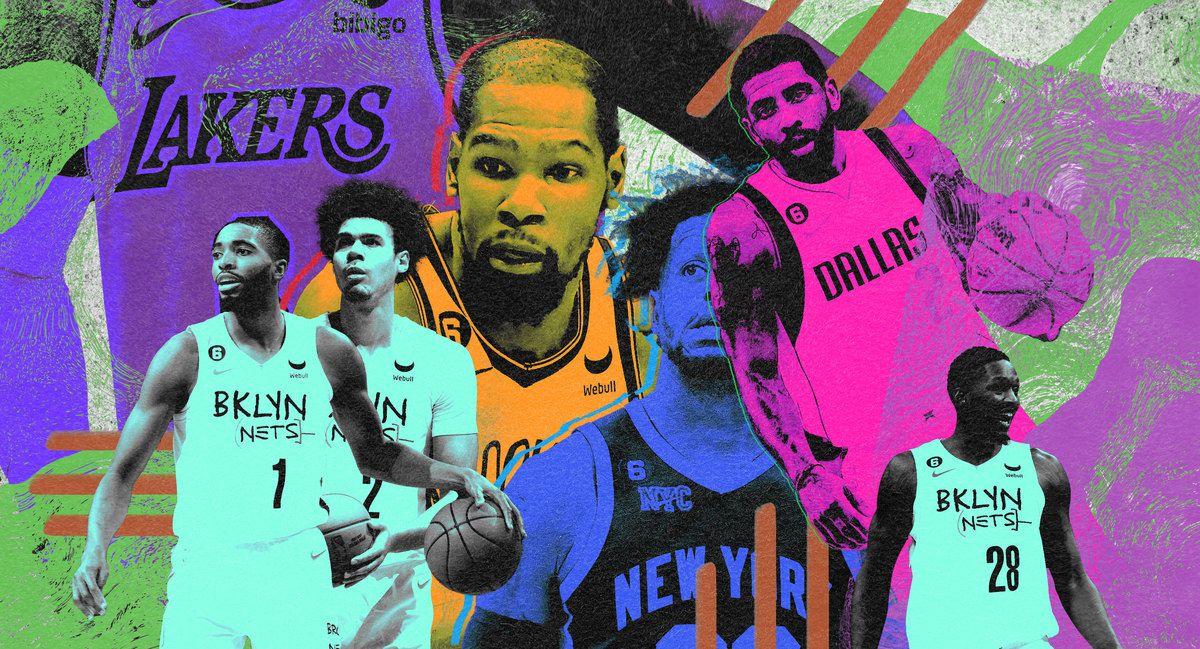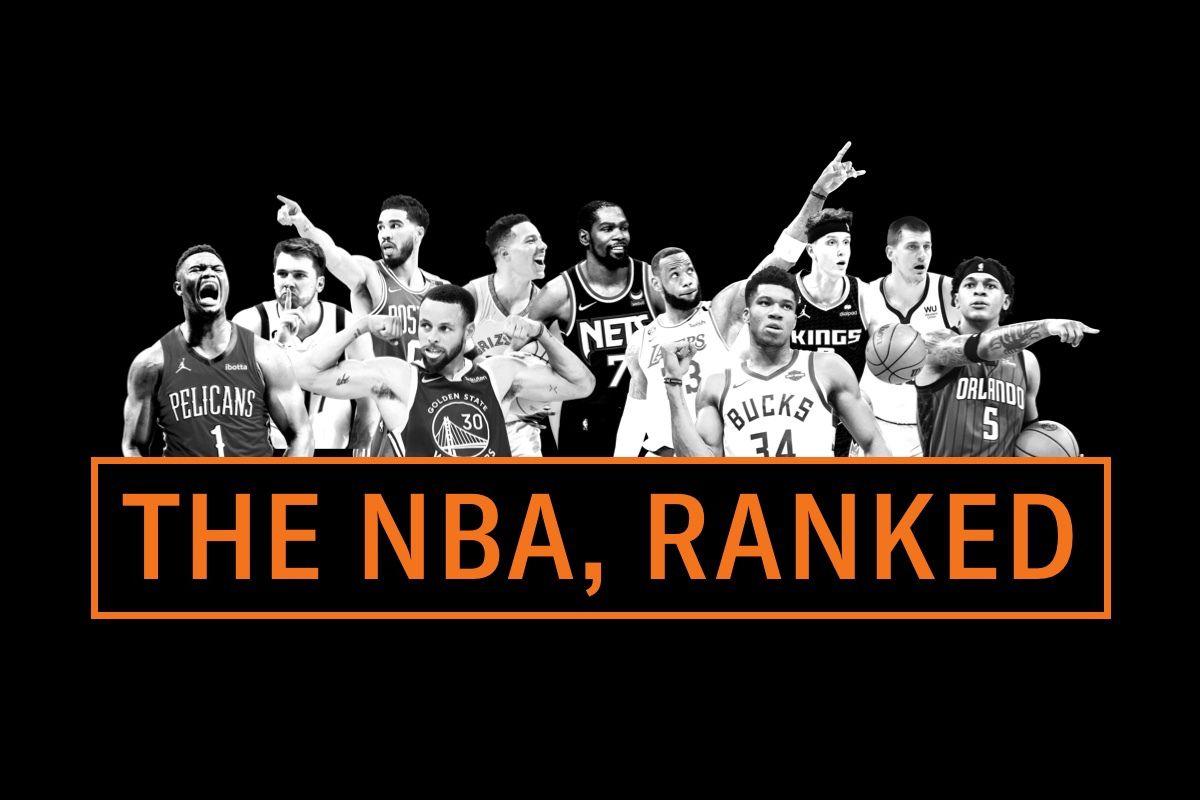If this NBA season has felt more chaotic than usual, it’s because there’s no team to beat. There’s no definitive superstar to chase. After years of inescapable dynasties and self-evident talent, the league has reset to its natural state: absolute mayhem, with contender after would-be contender vying to be the center of the basketball universe. That can be a little destabilizing for the regular-season experience; it’s hard to get a sense of what anything means without a gold standard, leaving us to measure flaws against flaws and streaks against streaks. It creates a field in which almost a third of the league has a realistic shot at the title—and any team among them could set the agenda for where the NBA goes next.
When every season went through the Warriors, Golden State created a league in its own image. Rival guards started imitating Steph Curry, launching their own side-step 3s and deep pull-ups. More high-level defenses were built around switching—in part because Golden State itself was a proof of concept, but also because it seemed like the only plausible way to slow the Warriors down. Teams swung trades and deployed season-long strategies specifically for the purpose of adapting to how Golden State played.
Attempting to tailor to any particular opponent in a season like this one, however, would be foolish. The Warriors are again the defending champions, but their place in the league has changed—to the point that they were among the teams looking to bolster their ranks at the trade deadline, something they never really had to do when they were racking up titles with the most stacked roster in the sport. This year’s deadline was telling in that no team made a dramatic swing for the sake of matchup concerns. Instead, we saw contenders double down on their own ways of life, betting on themselves in a league where so little seems certain. These final weeks before the playoffs will be unusually telling—a window to see which teams, after all the attrition of regular-season play, have reason to feel confident in what they do.
The wild swings in the standings this season have distracted from the fact that the NBA ecosystem is incredibly diverse—as varied, strategically, as it’s been in some time. The Celtics are near the top of the league in 3-point shooting frequency, and the Grizzlies are near the bottom. The Nuggets use more possessions in the post than any other team out there, while the Warriors are tied for using the second least. Even if you look under the hoods of the teams that seem to operate in similar ways, you’ll find that they rely on completely different engines. Joel Embiid and Nikola Jokic are amazing, hyper-productive centers who post up in volume and anchor their respective offenses, yet they seem to be playing entirely different sports. Styles make fights, and in this moment, the NBA is in an all-out brawl.
Over 82 games, that plays out as anarchy. In the silo of a single playoff series, everything narrows to the particulars of a matchup that even the most reliable contenders may not be entirely ready for. Even the Celtics—who have been the most convincing team from top to bottom this season—could have their hands full with the Bucks, Sixers, or Cavs, entirely because those teams aren’t interested in playing on Boston’s terms. Diversity of play isn’t just good for mixing up the product—it’s great for competition. Teams often get fixated on playing the same way because they believe it will help them maximize whatever edge the favorites have already captured. In reality, emulating the favorites often results only in doing the same things less effectively, surrendering a puncher’s chance for a pale imitation.
There will be none of that this season—not with this many different team constructions and strengths in the field. With chaos comes freedom. In some seasons, a team like Memphis might have felt pressure at the deadline to sacrifice what they are for the sake of what they thought they needed to be. It would have been understandable if the Grizzlies had countered the Suns’ blockbuster trade for Kevin Durant by trading for O.G. Anunoby, one of the few defenders in the world who could reliably check Durant in a playoff series. Yet doing so would reportedly have cost tons of draft capital and players who have been vital to the identity that makes Memphis a contender in the first place—a price too steep for Memphis to bear.
For as compelling as it would have been to see an already formidable Grizzlies team take a swing at the deadline, it would be an even bigger payoff to watch them break through without needing that kind of import. Besides: The real watch area for the Grizzlies isn’t how they might guard KD in a potential series that may never happen, but whether they can sustain the kind of steady half-court offense that will leave them less vulnerable to some of the other matchups in the West. A more consistent rhythm might help, considering that Ja Morant, Desmond Bane, and Jaren Jackson Jr. have played a grand total of 262 minutes together this season. Every opportunity they get to play together between now and April matters. Every second is instructive.
All of the viable contenders have their own burdens of proof and precious few games left to make any headway. We’re still finding out whether the Bucks—who triangulated their offense to such tremendous effect in prior postseasons—have the health and depth to be more than a battering ram this time around. Adding that shading is the only way to get past a hyper-balanced team like the Celtics, who have less to prove than most. Still: Acquiring Mike Muscala at the deadline felt like a quiet confirmation from Boston of something that’s been bubbling up all season. Al Horford, the 36-year-old big critical to the Celtics’ fluid style of play on both ends of the court, has slipped a bit this year. That might not seem like a big deal until the hope of a title suddenly hinges on Robert Williams III’s ability to stay healthy. Even one of the most talented rosters in the league can feel a pinch, and the homestretch should give us an indication of whether Boston is really deep enough in the ways it needs to be.
By adding Thomas Bryant and Reggie Jackson while shipping out Bones Hyland, Denver gave its own bench the kind of hard reset that could make or break its season. The sheer drop between the minutes Jokic plays and the ones he doesn’t remains a real pitfall for the Nuggets. Making those stretches even slightly more survivable would be a meaningful development and would further exaggerate the advantages Jokic creates against smaller teams like the Warriors and Mavericks. What Golden State needs most is to get healthy, though even that might not be enough to bail out an uncharacteristically mediocre defense. Two things can be true: that the Warriors have defended pretty well when Draymond Green and Andrew Wiggins have been on the floor together this season, as they often will be in the playoffs, and that the Warriors on the whole, even including Green and Wiggins at times, have shown the kinds of shaky habits in coverage that could submarine their title defense. You can’t keep up with movement offenses like Denver’s (or Sacramento’s, for that matter) if you’re not locked in on every detail.
Those same little things loom large for Philadelphia, particularly in their efforts to track and defend opponents who play a more free-flowing style. No one wants to challenge Embiid inside, but when opposing teams play decisively and move the ball, Philly can be prone to some glitches in focus and molasses-like closeouts. All’s well when the Sixers can contain and funnel the ball as planned, but much less so when they really have to scramble in coverage—they have a profile better suited to countering the Bucks than the Celtics, but maybe making room in the rotation for live-wire newcomer Jalen McDaniels can help to bridge the difference.
And then there’s Phoenix, with an offense that can’t really be stopped—in theory. Durant still hasn’t played a game for the Suns, or any games at all since early January. There’s plenty of work to be done in bringing the concept of the latest superteam to life, but if all goes according to plan, the Suns’ trio of pull-up maestros will be a particularly tough matchup for, say, the Grizzlies’ more conventional defense. Yet how will Phoenix slow Denver down? And now that Mikal Bridges is gone, who would the Suns even assign to guard someone like Luka Doncic or Kawhi Leonard? The perimeter defense is compromised in a way that puts more pressure on Durant and Deandre Ayton, the latter of whom has been alternately impressive and maddening. Maybe a trade like this will bring new clarity. Maybe it won’t.
Either way, the East can delight in the fact that Durant left the Nets and the conference as a whole. KD would have been a nightmare matchup for the Cavs, in particular—they have an otherwise elite defense still in search of a real answer at the 3. Maybe Cleveland’s best way forward isn’t settling on a one-size-fits-all starter but deciding which flawed option can survive best against every potential playoff opponent. Research is ongoing, though it’s certainly worth noting that designated stopper Isaac Okoro is shooting 40 percent from beyond the arc this month.
It feels like there’s always a lot for the Clippers to suss out at any given moment, between who’s actually available to play and how all the pieces of their loaded roster are supposed to fit together. The clock is ticking louder than ever now that they’ve completely redefined what they want out of the point guard position with just 21 games left on the schedule. Whether it’s Terance Mann, Hyland, or a bought-out Russell Westbrook in that spot, the playmaking flow within the Clippers offense is evolving—and with it, opponents’ understanding of where and how to apply pressure.
These trials are coming for every team in the running. We’ll undoubtedly see some of the sport’s finest ascend to levels we’ve never seen before, and we’ll celebrate the arc of their careers as they take shape. Yet this is a season of style in the NBA—an equalized field that makes how a team plays the crucial deciding factor. No contender is so talented as to overwhelm every team in their path. No lead is so commanding as to remove all doubt. The reason there are still so many questions left unanswered is because all this particular regular season can illustrate is a league at balance: that over a long enough timeline and against a wide swath of competition, many of the best teams will wind up in roughly the same place with roughly the same record.
There’s no real way to make up ground down the homestretch of this regular season because there’s no real front-runner. This time around, every contender is running its own race.


